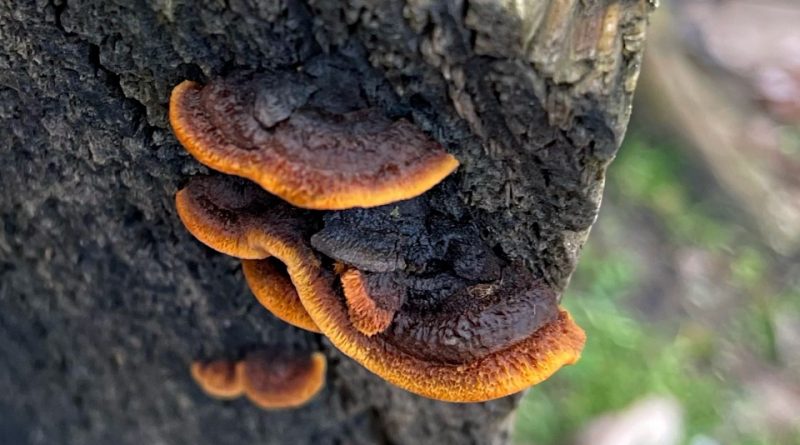Gloeophyllum sepiarium
Gloeophyllum sepiarium
The rusty-gilled polypore or conifer mazegill (Gloeophyllum sepiarium (Wulfen) P.Karst., 1882) is a mushroom belonging to the Gloeophyllaceae family.
Systematic –
From a systematic point of view it belongs to:
Eukaryota domain,
Fungi Kingdom,
Subdivision Agaricomycotina,
Class Agaricomycetes,
Subclass Incertae sedis,
Order Gloeophyllales,
Family Gloeophyllaceae,
Genus Gloeophyllum,
Species G. sepiarium.
The term is basionym:
– Agaricus sepiarius Wulfen.
The terms are synonymous:
– Agaricus asserculorum Batsch;
– Agaricus boletiformis Sowerby;
– Agaricus sepiarius subsp. sepiarius;
– Agaricus sepiarius var. vulgaris Alb. & Schwein.;
– Agaricus undulatus Hoffm.;
– Daedalea sepiaria (Wulfen) Fr.;
– Daedalea sepiaria (Wulfen) P.Gärtner, B.Meyer & Scherb., 1802;
– Daedalea sepiaria subsp. sepiaria (Wulfen) Fr.;
– Daedalea sepiaria subsp. undulata (Hoffm.) Pers., 1828;
– Daedalea sepiaria var. cinnamomea Pers.;
– Daedalea sepiaria var. dentifera Fr.;
– Daedalea sepiaria var. porosa Fr.;
– Daedalea sepiaria var. undulata Pers.;
– Daedalea ungulata Lloyd;
– Glocophyllum sepiarum (Wulfen) P.Karst.;
– Gloeophyllum ungulatum (Lloyd) Imazeki;
– Lenzites argentinus Speg.;
– Lenzites crocata (Sacc.) Sacc.;
– Lenzites sepiarius (Wulfen) Fr.;
– Lenzites sepiarius (Wulfen) P.Karst.;
– Lenzites sepiarius f. hydnoideus Henn.;
– Lenzites sepiarius f. monstrosus Pilát;
– Lenzites sepiarius f. resupinatus Pilát;
– Lenzites sepiarius var. fagi Nikol.;
– Lenzites sepiarius var. hydnoideus (Henn.) Sacc. & Traverso;
– Lenzites sepiarius var. porosa (Fr.) P.Karst.;
– Lenzites sepiarius var. porosus Peck;
– Lenzites sepiarius var. ruber Falck;
– Lenzitina sepiaria (Wulfen) P.Karst.;
– Merulius sepiarius (Wulfen) Schrank;
– Merulius sepiarius subsp. sepiarius;
– Merulius sepiarius var. integer Pers.;
– Merulius sepiarius var. prolifer Pers.;
– Merulius sepiarius var. subterraneus Pers.;
– Merulius squamosus Schrad., 1794;
– Pleuropus sepiarius (Wulfen) Zawadzki.
Etymology –
The term Gloeophyllum derives from the Greek gloiós, i.e. resin, gluten, rubber, from which the prefix gleo or gloeo, meaning resinous, glutinous, sticky, and phyllon, i.e. leaf, sheet.
The specific epithet sepiarium comes from the Latin “sepiárius”, that is, of cuttlefish, of ink (sépia = cuttlefish, ink + ater = dark, black).
Geographic Distribution and Habitat –
Gloeophyllum sepiarium is a mushroom with a wide distribution; it grows in various European countries, Central America and other areas, with a distribution in the temperate zones of the northern hemisphere.
This saprophytic fungus often grows on wood in lumberyards, the fruiting body grows for only one year and produces spores in late summer and autumn.
Its habitat is that of coniferous forests, rarely on broad-leaved trees, where it bears fruit in dry places, it is often found on worked wood (fences, piles of wood).
Recognition –
The Gloeophyllum sepiarium is a mushroom whose cap is vaguely fan-shaped, characterized by annual or perennial basidiomata, sessile or with the upper margin folded, usually co-colored with the pileal surface, rarely resupinated, isolated or fused laterally, hirsute, bristly, zoned. Its color ranges from brownish-yellow to reddish-brown, with individual fruiting bodies measuring 3-10 cm in length, 2-3 cm in width, while the thickness does not exceed 1 cm.
Its hymenial surface is distinguished from other polypores by the presence of gills.
The hymenium is predominantly lamellated, with thin lamellae 3-6 mm wide, entire or toothed, radial, sometimes the lamellae are anastomosed with each other forming mixed, poroid-lamellated zones, the frequency is 1-2 pores per mm and 15 -20 slats per cm, measured at the edge; the color of the gills is ocher, lighter than the context, with the edge covered with a hazelnut bloom.
The stem is absent.
The flesh is leathery, brown in color, with a thickness of about 5 mm and with no edibility of any value.
Under the microscope, a trimitic hyphal system is observed with frequent brown structural hyphae, with a diameter of up to 6 µm, rare, brown connective hyphae, with a diameter of up to 5 µm, hyaline generating hyphae with buckle joints with a diameter of 1.5 to 4, 5 µm; the cystidioles are hyaline and subulate, 12-35 × 3-7 µm; Cylindraceous basidiospores, hyaline, non-amyloid, 9-13 × 3-5 µm.
With KOH it takes on a blackish color.
Cultivation –
Gloeophyllum sepiarium is a wood decay fungus that causes brown rot.
However, it is not a cultivated mushroom.
Customs and Traditions –
Gloeophyllum sepiarium is an inedible mushroom, known by various common names; among these are: “Yesquero de las cercas” (Spanish); “Lenzite des clôtures” (French); “Zaun-Blättling” (German); “rusty gilled polypore“, “conifer mazegill” (English).
It is a common species, with a distribution in the temperate zones of the northern hemisphere. It is easy to confuse it with Gloeophyllum abietinum (Bulliard) P.Karsten 1882, which grows exclusively on conifers, preferring spruce. It can also be found on worked wood, on average smaller in size and amber-brown then blackish in colour, the lamellae are 8-12 per cm at the margins, interspersed with anastomosed lamellulae which are wider than in Gloeophyllum sepiarium, the cystidia are pointed with thickened walls and an apical crown of crystals. Gloeophyllum trabeum (Persoon) Murril 1908, prefers broad-leaved trees and its hymenium is predominantly poroid-daedaliform with pores and lamellae much denser than the other two species, smaller spores and tapered cystidia.
Other species similar to this mushroom are: Daedalea quercina, Lenzites betulina and Trametes versicolor.
G. sepiarium, like other polypores, contains tremethine or similar compounds.
Preparation Method –
Gloeophyllum sepiarium is not an edible mushroom.
Guido Bissanti
Sources
– Wikipedia, the free encyclopedia.
– GBIF, the Global Biodiversity Information Facility.
– Cetto B., 2008. Mushrooms from life, Saturnia, Trento.
– Pignatti S., 1982. Flora d’Italia, Edagricole, Bologna.
– Conti F., Abbate G., Alessandrini A., Blasi C. (ed.), 2005. An annotated checklist of the Italian vascular flora, Palombi Editore.
Photo source:
– https://inaturalist-open-data.s3.amazonaws.com/photos/253297074/original.jpg
Attention: Pharmaceutical applications and food uses are indicated for informational purposes only, they do not represent in any way a medical prescription; we therefore decline any responsibility for their use for healing, aesthetic or food purposes.


